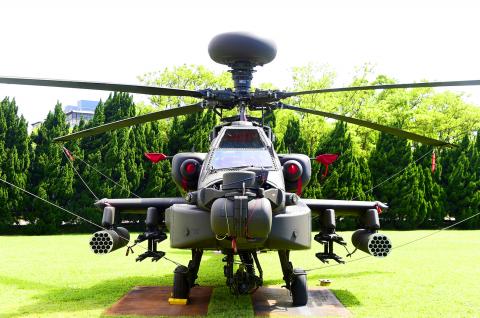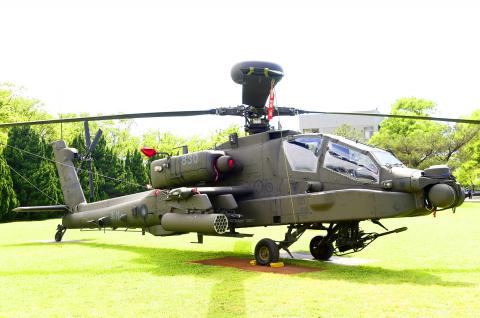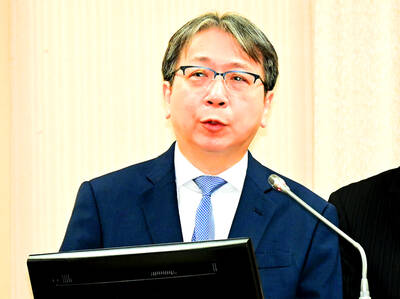The Republic of China Army 601st Air Cavalry Brigade is to formally become the first air brigade to be fully equipped with Boeing Co AH-64E Apache attack helicopters following a ceremony on Wednesday next week, a Ministry of National Defense official said yesterday.
President Tsai Ing-wen (蔡英文) is to officiate at the ceremony, which is being planned by the Army Command Headquarters, the official said on condition of anonymity.
Other distinguished guests would also attend the ceremony, where the helicopters’ capabilities would be demonstrated, he added.

Photo: Pan Shao-tang, Taipei Times
Some officials have said that in addition to Boeing representatives, several officers from the US Army’s 25th Combat Aviation Brigade, the air brigade’s sister unit, would also attend the ceremony.
When asked for comment, the ministry and headquarters declined to confirm or deny the claim, citing the sensitive nature of Taiwan-US relations.
The 601st and 602nd Air Cavalry brigades operate under the Army Aviation and Special Forces Command, with the former fielding all 29 of Taiwan’s serviceable Apaches and the latter fielding older AH-1W Cobra attack helicopters.

Photo: Pan Shao-tang, Taipei Times
Responsible for the defense of northern Taiwan, the 601st has two combat aviation squadrons that provide air support as part of the army’s air-land combined arms strategy, alongside armor, artillery, special forces and infantry units.
The first squadron, which has recently passed operational readiness evaluations, is tasked with training new Apache pilots in addition to its regular duties, the official said.
As the second squadron was declared operational in July last year, the entire brigade is now combat-ready, he said.
The Apache attack helicopter is a mobile and powerful weapons platform armed with a 30mm chain gun and, depending on the mission, a mixture of Hellfire anti-tank missiles, 2.75-inch Hydra rockets and Stinger air-to-air missiles, he said.
The Apache E variant’s most significant equipment is the Longbow fire-control radar located on top of the rotor mast, which provides day-and-night, all-weather, 360-degree search capabilities for air and ground targets, the official said.
The helicopter can simultaneously track 128 targets and engage 16 of them, making it more lethal and more likely to survive, he added.
Each Apache E can designate targets and extend air combat control to up to three other gunships, which means that the army does not need to equip all the helicopters with Longbow radar, he said.

The US government has signed defense cooperation agreements with Japan and the Philippines to boost the deterrence capabilities of countries in the first island chain, a report by the National Security Bureau (NSB) showed. The main countries on the first island chain include the two nations and Taiwan. The bureau is to present the report at a meeting of the legislature’s Foreign Affairs and National Defense Committee tomorrow. The US military has deployed Typhon missile systems to Japan’s Yamaguchi Prefecture and Zambales province in the Philippines during their joint military exercises. It has also installed NMESIS anti-ship systems in Japan’s Okinawa

‘WIN-WIN’: The Philippines, and central and eastern European countries are important potential drone cooperation partners, Minister of Foreign Affairs Lin Chia-lung said Minister of Foreign Affairs Lin Chia-lung (林佳龍) in an interview published yesterday confirmed that there are joint ventures between Taiwan and Poland in the drone industry. Lin made the remark in an exclusive interview with the Chinese-language Liberty Times (the Taipei Times’ sister paper). The government-backed Taiwan Excellence Drone International Business Opportunities Alliance and the Polish Chamber of Unmanned Systems on Wednesday last week signed a memorandum of understanding in Poland to develop a “non-China” supply chain for drones and work together on key technologies. Asked if Taiwan prioritized Poland among central and eastern European countries in drone collaboration, Lin

TRAGEDY STRIKES TAIPEI: The suspect died after falling off a building after he threw smoke grenades into Taipei Main Station and went on a killing spree in Zhongshan A 27-year-old suspect allegedly threw smoke grenades in Taipei Main Station and then proceeded to Zhongshan MRT Station in a random killing spree that resulted in the death of the suspect and two other civilians, and seven injured, including one in critical condition, as of press time last night. The suspect, identified as a man surnamed Chang Wen (張文), allegedly began the attack at Taipei Main Station, the Taipei Fire Department said, adding that it received a report at 5:24pm that smoke grenades had been thrown in the station. One man in his 50s was rushed to hospital after a cardiac arrest

ON ALERT: Taiwan’s partners would issue warnings if China attempted to use Interpol to target Taiwanese, and the global body has mechanisms to prevent it, an official said China has stationed two to four people specializing in Taiwan affairs at its embassies in several democratic countries to monitor and harass Taiwanese, actions that the host nations would not tolerate, National Security Bureau (NSB) Director-General Tsai Ming-yen (蔡明彥) said yesterday. Tsai made the comments at a meeting of the legislature’s Foreign Affairs and National Defense Committee, which asked him and Minister of National Defense Wellington Koo (顧立雄) to report on potential conflicts in the Taiwan Strait and military preparedness. Democratic Progressive Party (DPP) Legislator Michelle Lin (林楚茵) expressed concern that Beijing has posted personnel from China’s Taiwan Affairs Office to its